Strain Accumulation Along the Eastern Java Back–Arc Thrust System Inferred from a Dense Global Navigation Satellite System Network
Abstract
1. Introduction
2. Data and Methods
2.1. GNSS and Seismicity Data
2.2. Strain Rate
3. Result and Discussion
3.1. Displacement Rate
3.2. Regional Scale Strain Rate
3.3. Principal Strain Rate with Additional Campaign Observation
3.4. Maximum Shear and Dilatation Strain Rate with Additional Campaign Observation
3.5. Implication of Stress Accumulation and Earthquake Potential Stress
4. Conclusions
Supplementary Materials
Author Contributions
Funding
Data Availability Statement
Acknowledgments
Conflicts of Interest
References
- Silver, E.A.; Reed, D.; McCaffrey, R. Back Arc Thrusting in the Eastern Sunda Arc, Indonesia: A Consequence of Arc–Continent Collision. J. Geophys. Res. 1983, 88, 7429–7448. [Google Scholar] [CrossRef]
- Hutchings, S.J.; Mooney, W.D. The Seismicity of Indonesia and Tectonic Implications. Geochem. Geophys. Geosyst. 2021, 22, e2021GC009812. [Google Scholar] [CrossRef]
- Clements, B.; Hall, R.; Smyth, H.R.; Cottam, M.A. Thrusting of a Volcanic Arc: A New Structural Model for Java. Petrol. Geosci. 2009, 15, 159–174. [Google Scholar] [CrossRef]
- Kusuma, A.R.; Pratama, C.; Widjajanti, N.; Yulaikhah; Prayoga, O.; Kurniasari, E.D. Spatiotemporal Postseismic Due to the 2018 Lombok Earthquake Based on InSAR Revealed Multi Mechanisms with Long Duration Afterslip. J. Appl. Geod. 2024, 18, 473–482. [Google Scholar] [CrossRef]
- Yang, X.; Singh, S.C.; Tripathi, A. Did the Flores Backarc Thrust Rupture Offshore during the 2018 Lombok Earthquake Sequence in Indonesia? Geophys. J. Int. 2020, 221, 758–768. [Google Scholar] [CrossRef]
- Supendi, P.; Nugraha, A.D.; Widiyantoro, S.; Pesicek, J.D.; Thurber, C.H.; Abdullah, C.I.; Daryono, D.; Wiyono, S.H.; Shiddiqi, H.A.; Rosalia, S. Relocated Aftershocks and Background Seismicity in Eastern Indonesia Shed Light on the 2018 Lombok and Palu Earthquake Sequences. Geophys. J. Int. 2020, 221, 1845–1855. [Google Scholar] [CrossRef]
- Sasmi, A.T.; Nugraha, A.D.; Muzli, M.; Widiyantoro, S.; Syuhada, S.; Muttaqy, F.; Zulfakriza, Z.; Wei, S.; Priyono, A.; Afif, H.; et al. Shear Wave Splitting of the 2018 Lombok Earthquake Aftershock Area, Indonesia. Geosci. Lett. 2023, 10, 7. [Google Scholar] [CrossRef]
- Gunawan, E.; Amey, R.; Elliott, J.; Widiyantoro, S.; Puspito, N.T.; Hanifa, N.R.; Syamsuddin; Hussain, E. Coseismic Deformation of the 19 August 2018 Mw 7.2 Lombok Earthquakes, Indonesia, Estimated through InSAR and GPS Observations. Nat. Hazard 2023, 119, 545–558. [Google Scholar] [CrossRef]
- Koulali, A.; McClusky, S.; Susilo, S.; Leonard, Y.; Cummins, P.; Tregoning, P.; Meilano, I.; Efendi, J.; Wijanarto, A.B. The Kinematics of Crustal Deformation in Java from GPS Observations: Implications for Fault Slip Partitioning. Earth Planet. Sci. Lett. 2017, 458, 69–79. [Google Scholar] [CrossRef]
- Natawidjaja, D.H.; Sapiie, B.; Pamumpuni, A.; Marliyani, G.I.; Daryono, M.R. Baribis–Kendeng Thrust–fold Zone of Java, Indonesia: New Evidences of Active Back Arc Tectonics and their Implications to Seismic Hazards. In Proceedings of the Joint Convention Malang 2017, HAGI–IAGI–IAFMI–IATMI (JCM 2017), Malang, Indonesia, 25–28 September 2017. [Google Scholar]
- Marliyani, G.I. Neotectonics of Java, Indonesia: Crustal Deformation in the Overriding Plate of an Orthogonal Subduction System. Ph.D. Thesis, Arizona State University, Tempe, AZ, USA, 2016. [Google Scholar]
- Beckers, J.; Lay, T. Very Broadband Seismic Analysis of the 1992 Flores, Indonesia, Earthquake (Mw = 7.9). J. Geophys. Res. 1995, 100, 18179–18193. [Google Scholar] [CrossRef]
- Pranantyo, I.R.; Cummins, P.R. Multi–Data–type Source Estimation for the 1992 Flores Earthquake and Tsunami. Pure Appl. Geophys. 2019, 176, 2969–2983. [Google Scholar] [CrossRef]
- Ekström, G.; Nettles, M.; Dziewoński, A.M. The Global CMT Project 2004–2010: Centroid–moment Tensors for 13,017 Earthquakes. Phys. Earth Planet. Inter. 2012, 200–201, 1–9. [Google Scholar] [CrossRef]
- Patimah, S.H.; Gunawan, E.; Widiyantoro, S.; Triyoso, W. A Blind Thrust Fault Ruptured during the 10 October 2018 Situbondo, East Java, Indonesia, Earthquake Estimated using GNSS Data. Geotech. Geol. Eng. 2022, 40, 5717–5724. [Google Scholar] [CrossRef]
- Kreemer, C.; Blewitt, G.; Klein, E.C. A Geodetic Plate Motion and Global Strain Rate Model. Geochem. Geophys. Geosyst. 2014, 15, 3849–3889. [Google Scholar] [CrossRef]
- Heliani, L.S.; Pratama, C.; Wibowo, A.; Sahara, D.P.; Susilo, S.; Wibowo, S.T.; Safi’i, A.N.; Prayoga, O.; Sudrajat, A.; Fuady Bisri, M.B.; et al. Strain Accumulation in the Mentawai Forearc Sliver, Indonesia, Inferred from Continuous GNSS–derived Strain Rate. Geod. Geodyn. 2024, 1–6. [Google Scholar] [CrossRef]
- Raharja, R.; Ito, T.; Meilano, I. Evaluation of Earthquake Potential using a Kinematic Crustal Block Motion Model in Java, Indonesia, Based on GNSS Observation. J. Asian Earth Sci. X 2024, 11, 100171. [Google Scholar] [CrossRef]
- Gunawan, E.; Widiyantoro, S. Active Tectonic Deformation in Java, Indonesia Inferred from a GPS–Derived Strain Rate. J. Geodyn. 2019, 123, 49–54. [Google Scholar] [CrossRef]
- Purwaningsih, R.E.Y.; Sekarsari, A.; Sari, T.W.; Pratama, C.; Wibowo, S.T. Active Tectonics of the Eastern Java Based on a Decade of Recent Continuous Geodetic Observation. Geod. Geodyn. 2022, 13, 376–385. [Google Scholar] [CrossRef]
- Pratama, C.; Susanta, F.F.; Ilahi, R.; Khomaini, A.F.; Abdillah, H.W.K. Coseismic Displacement Accumulation Between 1996 and 2019 using a Global Empirical Law on Indonesia Continuously Operating Reference Station (InaCORS). JGISE J. Geospat. Inf. Sci. Eng. 2019, 2, 237–244. [Google Scholar] [CrossRef][Green Version]
- Altamimi, Z.; Rebischung, P.; Métivier, L.; Collilieux, X. ITRF2014: A New Release of the International Terrestrial Reference Frame Modeling Nonlinear Station Motions. J. Geophys. Res. Solid Earth 2016, 121, 6109–6131. [Google Scholar] [CrossRef]
- Herring, T.A.; King, R.W.; Floyd, M.A.; McClusky, S.C. Introduction to GAMIT/GLOBK Release 10.7. Department of Earth, Atmospheric, and Planetary Sciences Massachusetts Institute of Technology. 2018. pp. 1–50. Available online: https://geoweb.mit.edu/gg/Intro_GG.pdf (accessed on 2 August 2024).
- Estey, L.H.; Meertens, C.M. TEQC: The Multi–purpose Toolkit for GPS/GLONASS Data. GPS Solut. 1999, 3, 42–49. [Google Scholar] [CrossRef]
- Li, Y. Analysis of GAMIT/GLOBK in High–precision GNSS Data Processing for Crustal Deformation. Earthq. Res. Adv. 2021, 1, 100028. [Google Scholar] [CrossRef]
- Lyard, F.H.; Allain, D.J.; Cancet, M.; Carrère, L.; Picot, N. FES2014 Global Ocean Tide Atlas: Design and Performance. Ocean Sci. 2021, 17, 615–649. [Google Scholar] [CrossRef]
- Alif, S.M.; Ching, K.E.; Sagiya, T.; Wahyuni, W.N. Determination of Euler Pole Parameters for Sundaland Plate Based on Updated GNSS Observations in Sumatra, Indonesia. Geosci. Lett. 2024, 17, 615–649. [Google Scholar] [CrossRef]
- Simons, W.J.F.; Socquet, A.; Vigny, C.; Ambrosius, B.A.C.; Abu, S.H.; Promthong, C.; Subarya, C.; Sarsito, D.A.; Matheussen, S.; Morgan, P.; et al. A Decade of GPS in Southeast Asia: Resolving Sundaland Motion and Boundaries. J. Geophys. Res. Solid Earth 2007, 112, 1–10. [Google Scholar] [CrossRef]
- Sagiya, T.; Miyazaki, S.; Tada, T. Continuous GPS Array and Present–Day Crustal Deformation of Japan. Pure Appl. Geophys. 2000, 157, 2303–2322. [Google Scholar] [CrossRef]
- Shen, Z.K.; Wang, M.; Zeng, Y.; Wang, F. Optimal Interpolation of Spatially Discretized Geodetic Data. Bull. Seismol. Soc. Am. 2015, 105, 2117–2127. [Google Scholar] [CrossRef]
- Xi, C.; Wang, L.; Zhao, X.; Sun, Z.; Zhao, W.; Pang, M.; Wu, F. A Simple Weighting Method for Inverting Earthquake Source Parameters using Geodetic Multisource Data under Bayesian Algorithm. Geophys. J. Int. 2024, 237, 1142–1156. [Google Scholar] [CrossRef]
- Li, L.; Wu, Y.; Li, Y.; Zhan, W.; Liu, X. Dynamic Deformation and Fault Locking of the Xianshuihe Fault Zone, Southeastern Tibetan Plateau: Implications for Seismic Hazards. Earth Planets Space 2022, 74, 35. [Google Scholar] [CrossRef]
- Herring, T.A.; Melbourne, T.I.; Murray, M.H.; Floyd, M.A.; Szeliga, W.M.; King, R.W.; Phillips, D.A.; Puskas, C.M.; Santillan, M.; Wang, L. Plate Boundary Observatory and Related Networks: GPS Data Analysis Methods and Geodetic Products. Rev. Geophys. 2016, 54, 759–808. [Google Scholar] [CrossRef]
- Pratama, C.; Heliani, L.S.; Widjajanti, N.; Gunawan, E.; Anjasmara, I.M.; Novianti, S.T.; Sari, T.W.; Yuni, R.E.; Sekarsari, A. Recent GPS–Based Long Wavelength Crustal Deformation Revealed Active Postseismic Deformation Due to the 2006 Yogyakarta Earthquake. J. Appl. Geod. 2022, 16, 131–141. [Google Scholar] [CrossRef]
- Pratama, W.N.; Kita, S.; Imanishi, K. Stress Field Orientation Obtained from Earthquake Focal Mechanisms in Indonesia Region. Master’s Thesis, IISEE-GRIPS, Tokyo, Japan, 2022. [Google Scholar]
- Marliyani, G.I.; Helmi, H.; Arrowsmith, J.R.; Clarke, A. Volcano Morphology as an Indicator of Stress Orientation in the Java Volcanic Arc, Indonesia. J. Volcanol. Geotherm. Res. 2020, 400, 106912. [Google Scholar] [CrossRef]
- Rahmadani, S.; Meilano, I.; Susilo, S.; Sarsito, D.A.; Abidin, H.Z.; Supendi, P. Geodetic Observation of Strain Accumulation in the Banda Arc Region. Geomat. Nat. Hazards Risk 2022, 13, 2579–2596. [Google Scholar] [CrossRef]
- Guns, K.; Sandwell, D.; Xu, X.; Bock, Y.; Yong, L.W.; Smith–Konter, B. Seismic Moment Accumulation Rate from Geodesy: Constraining Kostrov Thickness in Southern California. J. Geophys. Res. Solid Earth 2024, 129, e2023JB027939. [Google Scholar] [CrossRef]
- Ward, S.N. A Multidisciplinary Approach to Seismic Hazard in Southern California. Bull. Seismol. Soc. Am. 1994, 84, 1293–1309. [Google Scholar] [CrossRef]
- Kostrov, V.V. Seismic Moment and Energy of Earthquakes, and the Seismic Flow of Rocks. Izv. Acad. Sci. USSR Phys. Solid Earth 1974, 1, 23–44. [Google Scholar]
- Nguyen, N.; Griffin, J.; Cipta, A.; Cummins, P.R. Indonesia’s Historical Earthquakes: Modelled Examples for Improving the National Hazard Map; Geoscience Australia: Canberra, Australia, 2015. [Google Scholar] [CrossRef]
- Sun, L.; Wang, L.; Xu, G.; Wu, Q. A New Method of Variational Bayesian Slip Distribution Inversion. J. Geod. 2023, 97, 10. [Google Scholar] [CrossRef]
- Wessel, P.; Smith, W.H.F.; Scharroo, R.; Luis, J.; Wobbe, F. Generic Mapping Tools: Improved Version Released. Eos Trans. Am. Geophys. Union 2013, 94, 409–410. [Google Scholar] [CrossRef]
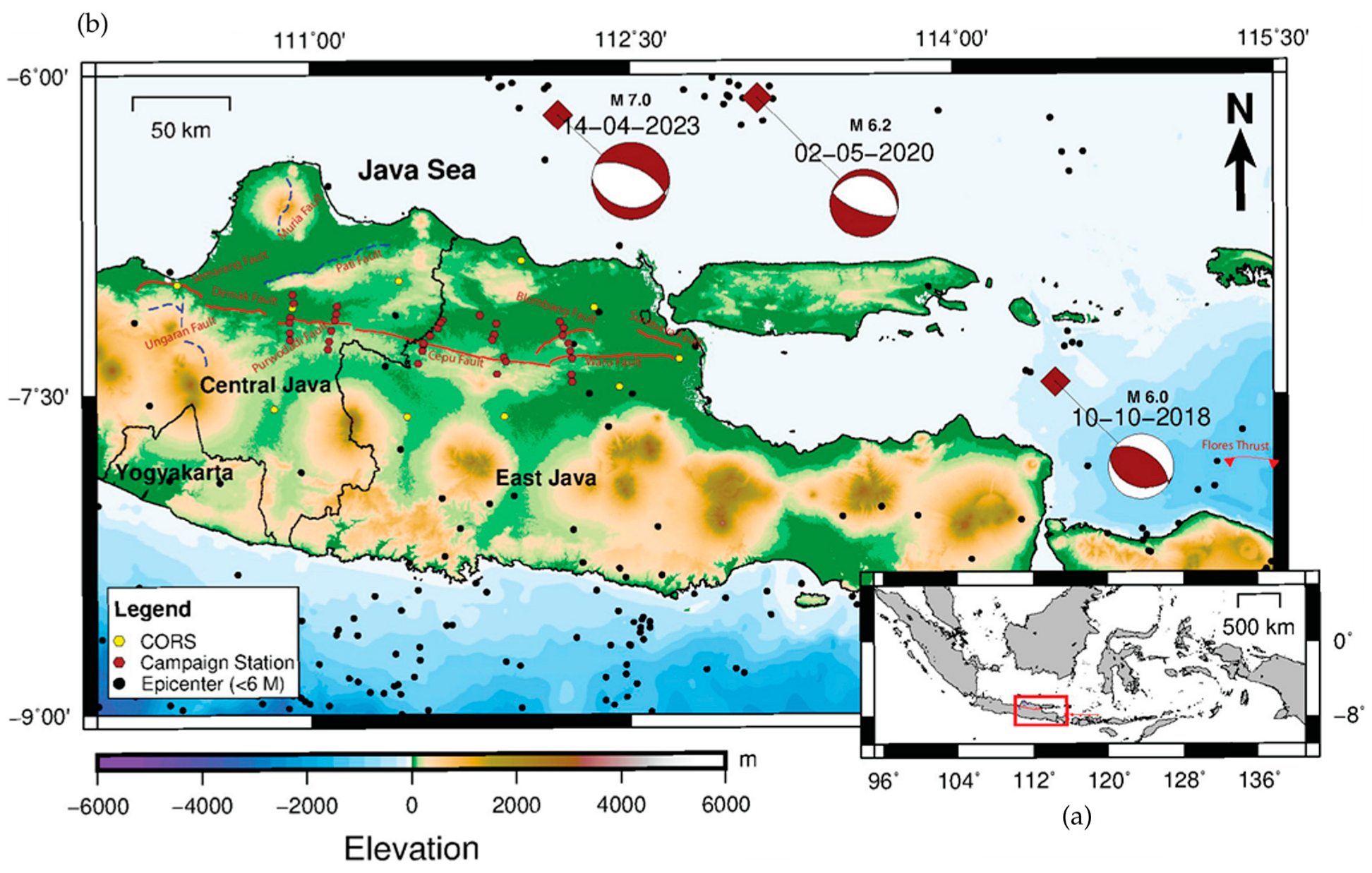
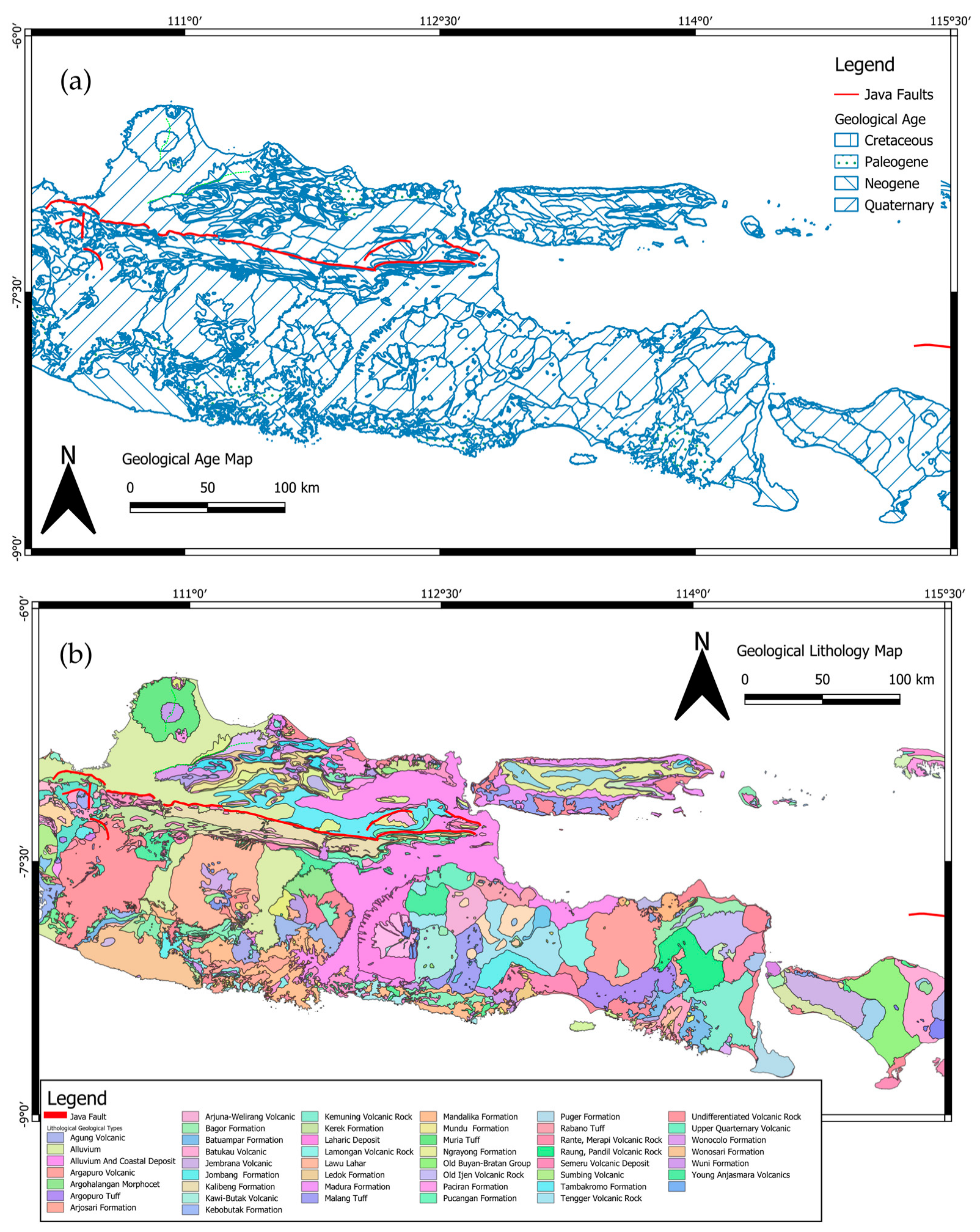
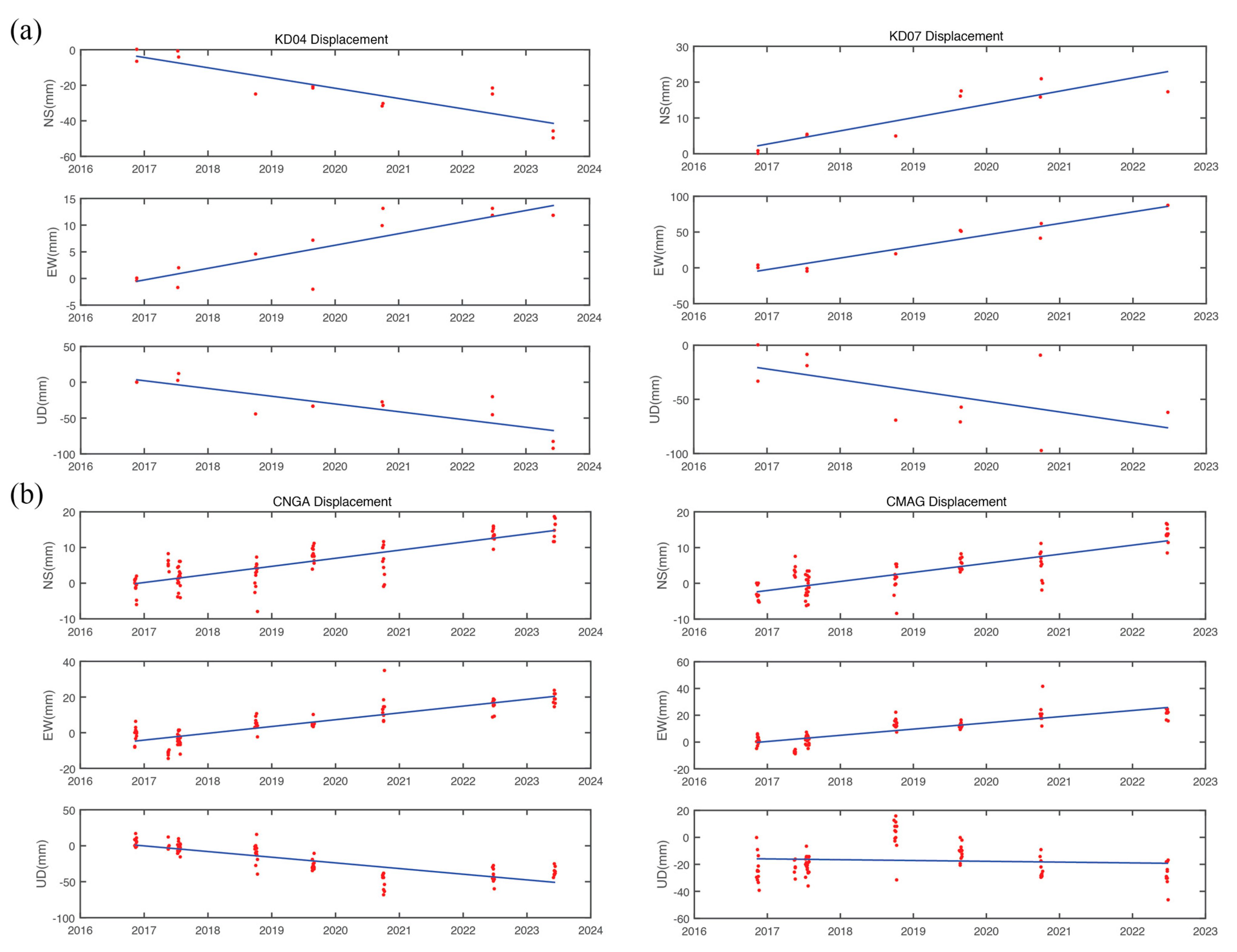

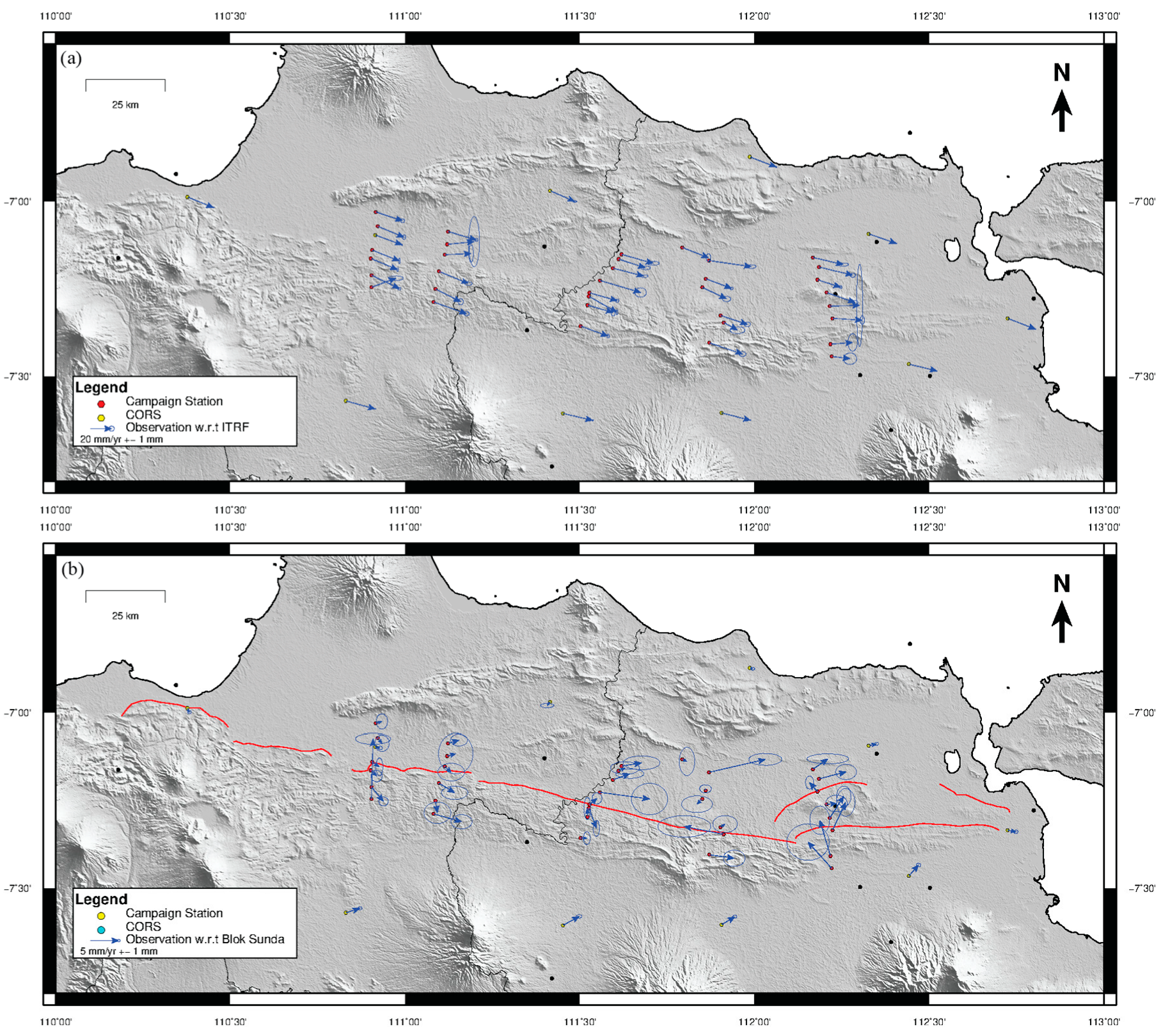
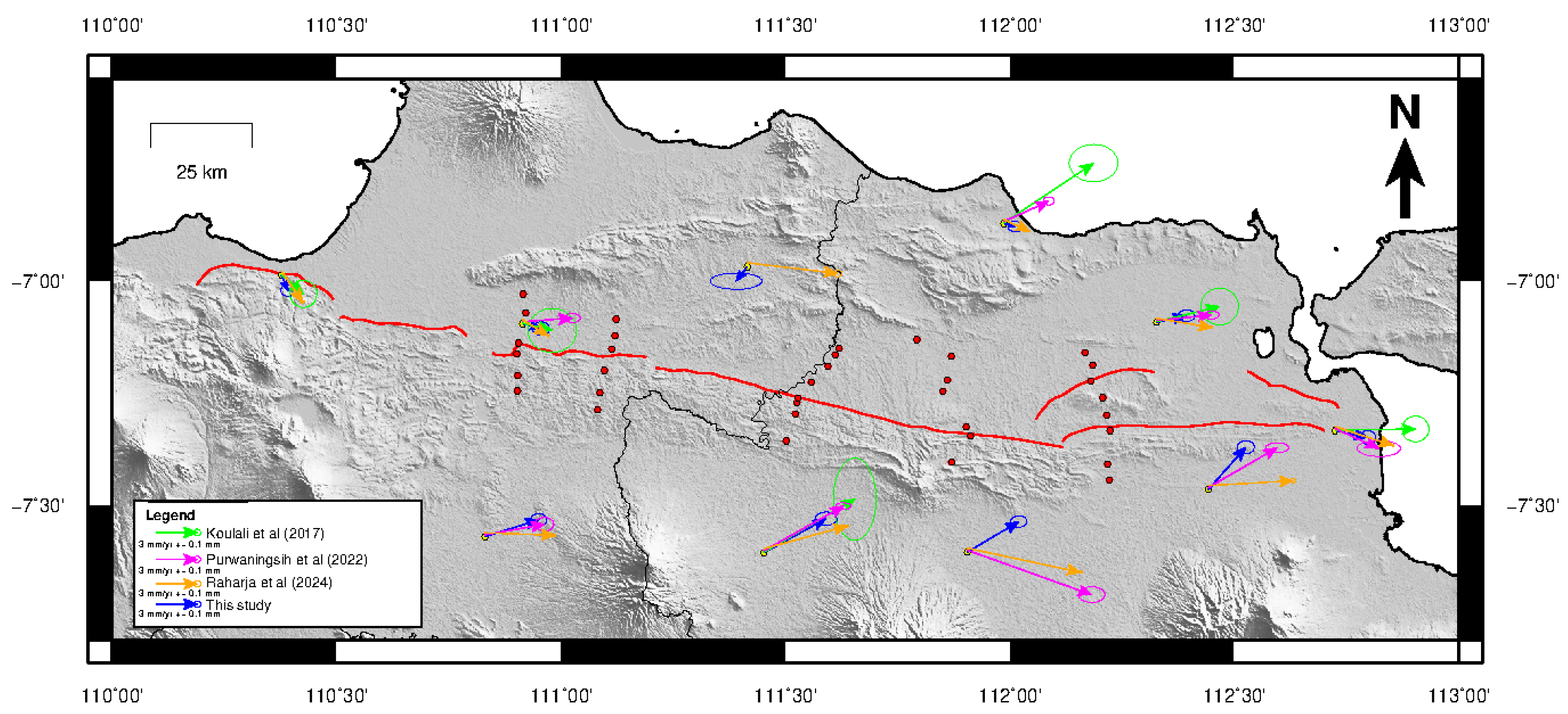

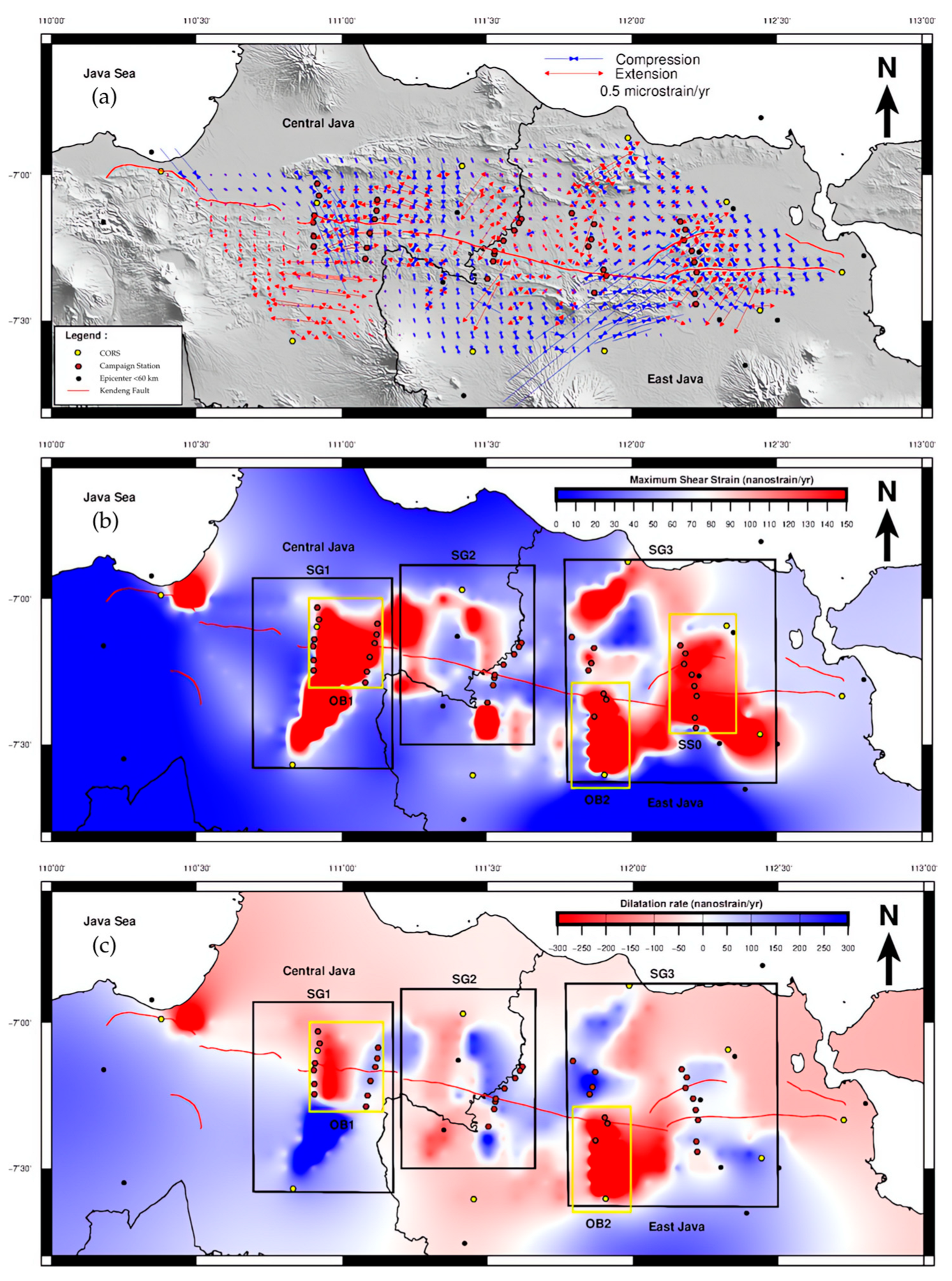
| No. | Station Name | Velocity with Respect to ITRF2014 | Velocity with Respect to Sunda Block | ||||||||||
|---|---|---|---|---|---|---|---|---|---|---|---|---|---|
| EW (mm) | NS (mm) | UD (mm) | σEW (mm) | σNS (mm) | σUD (mm) | EW (mm) | NS (mm) | UD (mm) | σEW (mm) | σNS (mm) | σUD (mm) | ||
| 1 | CBLR | 23.56 | −10.38 | 1.03 | 0.77 | 0.26 | 1.71 | −0.83 | −1.06 | 1.03 | 0.78 | 0.25 | 1.71 |
| 2 | CLMG | 26.43 | −9.18 | −6.32 | 0.22 | 0.17 | 0.69 | 2.22 | 0.48 | −6.32 | 0.25 | 0.18 | 0.69 |
| 3 | CMAG | 28.34 | −6.65 | −0.59 | 0.26 | 0.18 | 0.77 | 4.63 | 2.54 | −0.59 | 0.33 | 0.20 | 0.77 |
| 4 | CMJT | 26.84 | −6.59 | −7.01 | 0.20 | 0.18 | 0.56 | 2.78 | 3.14 | −7.01 | 0.26 | 0.20 | 0.56 |
| 5 | CNGA | 27.78 | −7.22 | −7.88 | 0.20 | 0.15 | 0.58 | 3.81 | 2.27 | −7.88 | 0.25 | 0.17 | 0.58 |
| 6 | CPWD | 25.58 | −9.41 | −9.21 | 0.22 | 0.20 | 2.25 | 1.37 | −0.36 | −9.21 | 0.26 | 0.21 | 2.25 |
| 7 | CSBY | 26.55 | −10.36 | −8.00 | 0.20 | 0.19 | 0.56 | 2.43 | −0.51 | −8.00 | 0.23 | 0.21 | 0.56 |
| 8 | CSEM | 24.91 | −10.02 | −5.34 | 0.18 | 0.18 | 0.57 | 0.51 | −1.15 | −5.34 | 0.22 | 0.18 | 0.57 |
| 9 | CSLO | 27.96 | −7.74 | −1.21 | 0.20 | 0.17 | 0.65 | 4.01 | 1.27 | −1.21 | 0.24 | 0.18 | 0.65 |
| 10 | CTBN | 25.19 | −9.77 | −2.60 | 0.20 | 0.16 | 0.52 | 0.85 | −0.24 | −2.60 | 0.23 | 0.16 | 0.52 |
| No. | Station Name | Koulali et al. [9] | Purwaningsih et al. [20] | Raharja et al. [18] | This Study | ||||
|---|---|---|---|---|---|---|---|---|---|
| EW ± σ (mm) | NS ± σ (mm) | EW ± σ (mm) | NS ± σ (mm) | EW ± σ (mm) | NS ± σ (mm) | EW ± σ (mm) | NS ± σ (mm) | ||
| 1 | CBLR | N/A | N/A | N/A | N/A | 6.7 ± 0.13 | −0.79 ± 0.10 | −0.83 ± 0.78 | −1.06 ± 0.25 |
| 2 | CLMG | 4.68 ± 0.57 | 1.13 ± 0.56 | 4.07 ± 0.23 | 0.37 ± 0.12 | 4.1 ± 0.03 | −0.70 ± 0.03 | 2.22 ± 0.25 | 0.48 ± 0.18 |
| 3 | CMAG | 6.76 ± 0.65 | 3.94 ± 1.25 | 5.92 ± 0.22 | 3.32 ± 0.11 | 6.2 ± 0.03 | 1.70 ± 0.03 | 4.63 ± 0.33 | 2.54 ± 0.20 |
| 4 | CMJT | N/A | N/A | 5.11 ± 0.34 | 2.97 ± 0.15 | 6.3 ± 0.08 | 0.36 ± 0.06 | 2.78 ± 0.26 | 3.14 ± 0.20 |
| 5 | CNGA | N/A | N/A | 9.22 ± 0.40 | −3.32 ± 0.24 | 8.4 ± 0.04 | −1.80 ± 0.04 | 3.81 ± 0.25 | 2.27 ± 0.17 |
| 6 | CPWD | 2.21 ± 0.74 | −0.54 ± 0.67 | 3.70 ± 0.25 | 0.27 ± 0.14 | 1.9 ± 0.03 | −1.20 ± 0.03 | 1.37 ± 0.26 | −0.36 ± 0.21 |
| 7 | CSBY | 5.96 ± 0.41 | 0.08 ± 0.39 | 3.23 ± 0.66 | −1.47 ± 0.25 | 4.3 ± 0.02 | −1.40 ± 0.02 | 2.43 ± 0.23 | −0.51 ± 0.21 |
| 8 | CSEM | 1.64 ± 0.41 | −1.45 ± 0.41 | N/A | N/A | 1.6 ± 0.07 | −2.30 ± 0.03 | 0.51 ± 0.22 | −1.15 ± 0.18 |
| 9 | CSLO | N/A | N/A | 4.41 ± 0.29 | 0.78 ± 0.20 | 5.2 ± 0.03 | −0.18 ± 0.03 | 4.01 ± 0.24 | 1.27 ± 0.18 |
| 10 | CTBN | 6.66 ± 0.74 | 4.44 ± 0.57 | 3.33 ± 0.17 | 1.51 ± 0.12 | 1.9 ± 0.03 | −0.87 ± 0.02 | 0.85 ± 0.23 | −0.24 ± 0.16 |
Disclaimer/Publisher’s Note: The statements, opinions and data contained in all publications are solely those of the individual author(s) and contributor(s) and not of MDPI and/or the editor(s). MDPI and/or the editor(s) disclaim responsibility for any injury to people or property resulting from any ideas, methods, instructions or products referred to in the content. |
© 2024 by the authors. Licensee MDPI, Basel, Switzerland. This article is an open access article distributed under the terms and conditions of the Creative Commons Attribution (CC BY) license (https://creativecommons.org/licenses/by/4.0/).
Share and Cite
Widjajanti, N.; Pratama, C.; Azizi, I.H.; Yulaikhah, Y.; Abiyyu, M.F.; Rahman, S.A.; Cahyadi, M.N.; Aprianti, E.; Prayoga, O. Strain Accumulation Along the Eastern Java Back–Arc Thrust System Inferred from a Dense Global Navigation Satellite System Network. Geosciences 2024, 14, 346. https://doi.org/10.3390/geosciences14120346
Widjajanti N, Pratama C, Azizi IH, Yulaikhah Y, Abiyyu MF, Rahman SA, Cahyadi MN, Aprianti E, Prayoga O. Strain Accumulation Along the Eastern Java Back–Arc Thrust System Inferred from a Dense Global Navigation Satellite System Network. Geosciences. 2024; 14(12):346. https://doi.org/10.3390/geosciences14120346
Chicago/Turabian StyleWidjajanti, Nurrohmat, Cecep Pratama, Iqbal Hanun Azizi, Yulaikhah Yulaikhah, Muhammad Farhan Abiyyu, Sheva Aulia Rahman, Mokhamad Nur Cahyadi, Evi Aprianti, and Oktadi Prayoga. 2024. "Strain Accumulation Along the Eastern Java Back–Arc Thrust System Inferred from a Dense Global Navigation Satellite System Network" Geosciences 14, no. 12: 346. https://doi.org/10.3390/geosciences14120346
APA StyleWidjajanti, N., Pratama, C., Azizi, I. H., Yulaikhah, Y., Abiyyu, M. F., Rahman, S. A., Cahyadi, M. N., Aprianti, E., & Prayoga, O. (2024). Strain Accumulation Along the Eastern Java Back–Arc Thrust System Inferred from a Dense Global Navigation Satellite System Network. Geosciences, 14(12), 346. https://doi.org/10.3390/geosciences14120346






